Menus
- The devil in detail !
- 4th generation of Diablo
- Discovery
- In the city
- On the road
- On the highway
- In the wet
- Conclusion
- Pirelli Diablo Rosso IV tire dimensions
- Indicative price of Pirelli Diablo Rosso IV tires
The devil in detail !
The Diablo Rosso IV is the latest Pirelli sport tire and yet intended for road use. The latest tire once again sets the bar very high in the category and upgrades its structure and composition in order to best meet the expectations of the most experienced drivers, but also of manufacturers wishing to offer the flagship of their high-end slippers brand. It was in the Vexin that we put them to the test.
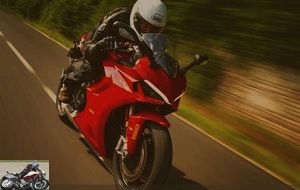 Pirelli Diablo Rosso IV tire test
Pirelli Diablo Rosso IV tire test
Serge Nuques, knight of Groland and experienced road pilot, made the trip from his Basque Country (or Groland?) For the occasion. Temporarily leaving his trainees, his idyllic environment for motorcycling and taking advantage of a short "break" between his training sessions, including on the track, he thus came to conquer the countryside of the north-west of the Paris region and to remember fond memories of the invited journalists. It was therefore with pleasure that we discovered the itinerary concocted by the French Pirelli team by following in his footsteps. So, are we ready to go on a cruise (it’s always less dangerous than a crusade), with the new Diablo Rosso IVs? Maybe, but first, a technical round is called for.
4th generation of Diablo
Since 2002 and the release of the first Diablo, followed by the Diablo Rosso in 2007, Rosso II in 2010, Rosso III in 2016, Pirelli is in the 4th generation of its sports tires. The changes made over time are important, both in terms of gum compound and in terms of the composition of the carcass, as well as the design. Better yet, the benchmark road sport tire offers several options depending on the size of the tires..
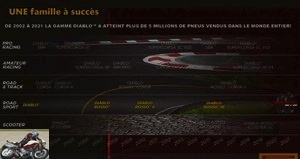 The evolution of the Diablo range since 2002
The evolution of the Diablo range since 2002
The more powerful your motorcycle, the faster it is and the more likely it is to put the wheels on the track, the more likely it is to benefit from a composition reserved for motorcycles in 190/55 and more at the rear: the 3LC , with 3 different types of rubber instead of 2 (dual rubber for smaller dimensions). This rear tire for large sizes and 55 high sidewall offers a tread covering 20% of the surface, followed by 19% softer intermediate compound and 100% silica. The remaining 21% are free of sculptures and offer a racing compound equivalent to that found on the SuperCorsa III. This part of the tire is accessed from 35 ° angle exceeded and the compound is this time loaded with carbon black to offer stability and resistance to the high temperatures generated by a racing style.
Another point specific to large tires: the Rayon structure, an eco-sustainable natural fiber (registered trademark), supposed to significantly improve the driving sensations and the response to acceleration by means of a reduced deformation, while providing an ecological guarantee for a tire, which we know very well that it is not easy to claim that it is “green”. But a tire that lasts is a greener tire, and a tire that uses renewable resources is too. So this Diablo is a greener tire ….
 The Diablo Rosso family arrives at its fourth generation
The Diablo Rosso family arrives at its fourth generation
Hypersport machines 1000 and up will appreciate, as will H2 and company style “fire pumps”. The 2010 CBR 1000 RR, which will serve as the master stallion, falls into this category of tires..
What if the tire is less than 190/55 at the rear, with 190/50 for example, or 180 wide? This will be only dual compound, with a tread representing 25% of the surface and quick to heat up quickly, while holding well on wet roads and 38% on the sidewalls of the tire, with a compound rich in silica. This is the case with the Ducati Supersport 950 S that we are testing today. Note that the "hard" tread has been widened by 5% compared to the Diablo Rosso III, which allows to consider less wear and better handling in the wet, as claimed by Pirelli. Among others. On the other hand, the strings are now in Lyocell (registered trademark), an ultra-strong 3-ply fiber that is also found in …. Pirelli mattresses. Real thing. If with that, it does not cushion better !
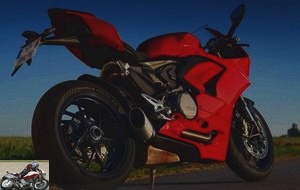 We were able to test the DRIV on the Ducati SuperSport 950 S
We were able to test the DRIV on the Ducati SuperSport 950 S
Whatever the size of the tire, there is a double compound at the front representing a distribution of 33% harder rubber in the center, supported by 33% softer rubber on the sidewalls. About the flank, precisely, not to be confused with the blank, intended to fill the void, the strings of the transverse weft of the Rosso IV are of lesser density than in the past and above all more rigid, in theory providing a better feedback and increased maneuverability. In addition, the front tire would benefit from a higher lean angle, able to withstand greater stress. Understand that braking on the angle could be maintained for a longer time, over a larger area, allowing the distance to be reduced and the brakes to enter harder on a curve to release them later. We’ll skip the details, but Pirelli claims to have gained more than 2 seconds per lap on an S1000 RR between the Rosso III and the Rosso IV, while gaining in handling, grip, holding…. The only point not to do better in theory? The maximum mileage. You can draw on certain parameters, but if you aimed even more, you would lose tire life. Which would no longer be acceptable for a road tire. We will see if this is still the case in 4 years, with the Rosso V !
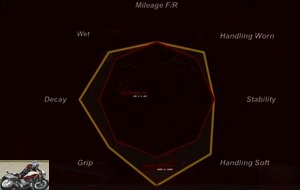 The announced differences between the Diablo Rosso III and IV
The announced differences between the Diablo Rosso III and IV
Discovery
To begin with, we will appreciate the design of the sculptures, still as aggressive and characteristic of the brand’s sports tires. The lightning bolts dear to the Pirelli sports tire family are being reviewed again this year to further verticalize the structures and remove water as well as possible. We immediately appreciate the "slick" aspect offered by the edge of the Diablo IV, while reassuring ourselves that the wet is also in the chemistry that we fight. Because when it comes to thinking that we’re going to stick it out at full angles, there is room. On the other hand, the “flash” structures also serve to optimize the micro mobility of the rubber, according to Pirelli. Which means ? That the internal movements of the rubber, the connections between the elements composing it and the wear of the tire coating would be better controlled, making it possible to maintain a pleasant profile throughout the life of the tires, but also and above all not to not induce inappropriate wear, staircase style or "intermediate firing" of the rubber, harmful to the guidance.
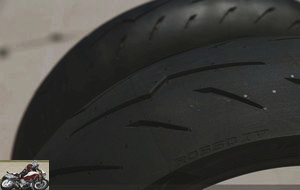 The tire design is always aggressive with its ‘flash’ characteristics
The tire design is always aggressive with its ‘flash’ characteristics
The side "accents" are intended to even out the wear, while providing more drainage of any film of water on the intermediate corner. In addition, this drawing is sold to allow better feedback on curves. For now, all that matters is aesthetics and the least we can say is that a Diablo, it has a sharp, sharp look and a really sporty profile.
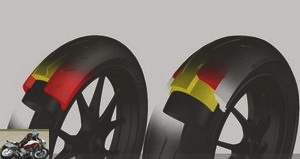 The front remains a bigomme and the rear is presented as a bigomme or trigomme depending on its size.
The front remains a bigomme and the rear is presented as a bigomme or trigomme depending on its size.
When looking at the rear tire "from the front", it shows three distinct parts, each of which offers an optimized contact property and surface with the road and its surface. Round on the tread, thanks to a fairly narrow surface and particularly loaded with rubber, we then approach a more convex shape, before forming a lip on the outside of the tire. In short, a sort of Napoleonic hat upside down, with obvious ground contact properties. The more you take the angle, the more you land on the sides, which offer a progressive shape and best follow the "flat" of the road. The prerogative of sports tires, of course, but here very marked, even once the carcass is in pressure on the rim. Pressure set at 2.4 in the front and 2.4 in the rear. No jealousy, but here too a sensitivity to the ambient temperature with regard to the normal recommendations of Pirelli (2.5 – 2.9 on the road). Yes, but there you have it, the weather is nice, it’s hot and when it does, the air in the tires expands further.
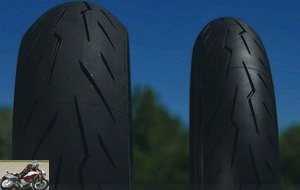 The rear forms three distinct parts
The rear forms three distinct parts
In order to maintain a fairly supple carcass (we are still on bumpy roads and in variable condition), therefore a satisfactory level of comfort and to allow a good feeling, Pirelli recommended a relatively low pressure at the rear. The break-in should therefore be faster too, even if it means adding a little heaviness to the rear. And if we went to see that, on the handlebars of the Supersport 950 S? On the same route as in the morning with the Angel GT II, here we are to discover a metamorphosed motorcycle !
In the city
Chaussee des Diablo IV, the Supersport regains a liveliness that disappeared that very morning. Already, the front axle regains vigor and the U-turns are carried out more quickly. If they are a little drier, less filtering and above all more talkative about what they encounter, the Diablo IV participate in improved handling and regained. Better yet, we rediscover the rear axle and especially the braking. While the Angel GT II had annihilated any progressiveness at low speed, we find all the sensations in the pedal, a much better definition of braking and a most appreciable grip, avoiding the systematic blockages experienced with GT sport tires. Better yet, you push the limits of braking and even the front becomes more aggressive. Understand that the right lever retains the same power, the same feeling, but that the effects are much better received by the front tire, which literally "sticks" the rubber in the asphalt. Results ? Even with ABS, you lift the rear wheel without triggering the anti-lock, which is almost impossible with morning tires. Conclusion? A sporty rubber is a game-changer, even on the tread. Better yet, the Diablo Rosso IVs go really well with the assistance, while doing largely as well without: they amplify the braking..
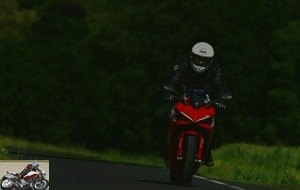 Lively, the Diablo Rosso IV offers a lot of feedback
Lively, the Diablo Rosso IV offers a lot of feedback
Despite the low pressure of the rear tire, you do not feel the inertia of the drive train. The work on the carcass and on its rigidity is obvious, naturally compensating for the induced deformation. It may be less air, the behavior is still very natural and instinctive. Surprising and pleasant. The tire profile helps maneuver and also compensates.
On the road
The break-in is indeed very fast and immediate confidence building: it holds strong to the ground. We quickly find ourselves "at home", again enjoying great handling, reinforced by a feeling of sticking to the road. The angle setting is both precise and regular, fast and intuitive, while the trajectory is corrected at will. Here too, the harmony between the rear axle and the front axle is natural – while feeling a very little resistance due to the lower pressure at the rear – and without fail, with new tires. However, we appreciate the entry into the curve without significant effort, done with tact and above all the possibility of braking as desired before and during the turn. On the corner? The motorcycle does not stand up and does not induce any negative feedback in the steering. Result ? We dive more easily in a tight curve, we even correct the brake and above all, we can re-accelerate very early in the turn without having to fear traction control intervention if it is set to the minimum. Even better if it’s disabled! Traction is excellent regardless of the area of the tire used and you do not feel the transitions between the compounds or the changes in profile.
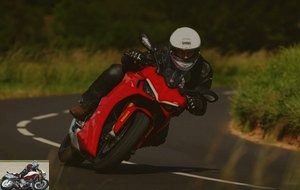 Setting the angle is quick and intuitive
Setting the angle is quick and intuitive
On the other hand, the Diablo Rosso IV cash – without amplifying that said – the slightest imperfection. They return information mainly through the saddle, which the delicate and attentive glutes will have to contend with. Or opt for a comfort saddle. An adjustment of the suspensions will perhaps be necessary, according to the rise which you leave in favor of this one. If you are used to GT Sport tires, it is a bit dry, but the good thickness rubber still does its job by reducing the rendering. To see if at half-wear and then, we keep this benefit. We do not take off the dentures at the slightest bump, even if it can hit "a little". In view of the benefit and especially the information returned, one is more forgiving than one is attentive to the reactions of the bike and to the road conditions and grip. If you are looking for comfort, filtration and reaction damping, go your way or opt, as we have just mentioned, for an adaptation of the fork and the shock absorber (s).
As for traction control, on dry roads, its entry into action was purely and simply eliminated on a motorcycle of measured power (110 hp), but the road conditions were excellent and the passages in gravel and other traps will not have not involve the device.
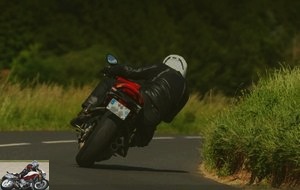 The other side of the coin, the Pirelli are quite ‘dry’ and not very comfortable
The other side of the coin, the Pirelli are quite ‘dry’ and not very comfortable
On the highway
On what ? Highway ? We didn’t have time to test a long straight in Germany during our test. However, the stability of the Diablo IV is appreciable and we can guess that if it rains peaks in excess of 300 and the brakes to follow, it should not induce parasitic movement. Our long-term test of the Diablo Rosso IV on the benchmark CBR will tell us that. Because yes, we put them on our CBR to continue the test over a long distance (article which will therefore be enriched).
On the other hand, we appreciate that the central rubber of the front and rear tires is harder, which can presage good resistance in the context of reasonable and reasoned use on the motorway. The tires we recovered had completed 3 circuit sessions at Magny-Cours and were not marked, the thickness of the rubber still appearing to be intact compared to a new tire. We will measure the wear according to the different types of trips and roads and give you our report by the end of the life of the Diablo IV train.
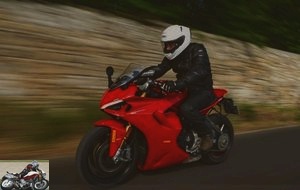 Unsurprisingly, DRIVs adapt perfectly to high speeds
Unsurprisingly, DRIVs adapt perfectly to high speeds
In the wet
Impossible for us to judge the qualities of the Diablo Rosso IV in the wet. Quite simply because no drop has come to blacken the sky or the road…. A thought for the Pirelli team who, during the reconnaissance, had suffered the wrath of the sky and been copiously watered !
However, the handling should be improved compared to previous generations, mainly by the chemistry of the tires, reinforced to better hold in the wet. So we’ll see if we get the maximum angle in the rain, as we did with the Bridgestone T32s, for example. An angle estimated at more than 53 ° according to Pirelli’s words (in the dry). Like any sporty tire, it will be necessary to call on skills in positioning on the motorcycle and wiggling when the rain is the part, this in order to stay in the zone of "comfort" which seems possible: that between the tread and the birth of the slick part of the tire, ie approximately 35 to 45 ° of angle. How to measure it? Looking for the limits, my general! We hope that the stall will be gradual, as well as the recovery of grip ….
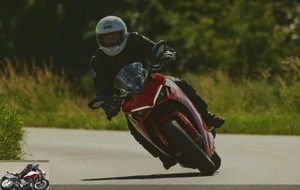 This first handling did not put the Pirelli to the test in the wet
This first handling did not put the Pirelli to the test in the wet
Conclusion
While sports tires were once very different from road tires, the frontiers have tended to diminish in recent years, with the former becoming more enduring and the latter improving their grip. While you don’t expect the same level of comfort from a sport tire as that found in a GT tire, lower pressure and the new progressive carcass have brought their share of deformation that is beneficial to well-being on board. On the other hand, the Diablo Rosso IV remains an expressive tire, returning invaluable information for a pilot, while evacuating the parasitic sensations..
Thanks to the work carried out, the new generation of Rosso is even easier to understand and more versatile. It comes into operation more quickly and lends itself readily to road use and for good reason: the range of the Italian manufacturer is extensive and each niche has its own arguments. That of the Rosso is to be a tire that is certainly sporty, "with competition pieces in it", particularly in terms of rubber compounds, but whose properties, profile or even tread are fully adapted to the practice of riding. road and a certain longevity without sacrificing performance.
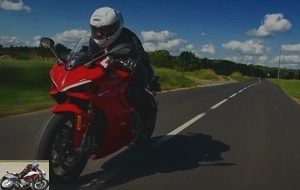 Pirelli Diablo Rosso IV
Pirelli Diablo Rosso IV
What was the point of opting for them, then? For their grip, for their road feel, for what they are able to improve the intrinsic characteristics of your bike and bring out (while briefly erasing it) the slightest defect in the suspension settings. They will be more sensitive to pressure, but will allow you to push the limits of braking, delay the intervention of assistance, or even improve your performance on the track, if you decide to take them there. Who would have known until recently that the Diablo Rosso IV could be so versatile and considerate? In the meantime, for less than 300 €, it is very likely that we adopt them, which we have just done to take the continuation of the Angel GT II mounted on our test CBR 1000 RR. Because to choose between an Angel GT II more road and more durable and a sport tire offering a less longevity, I choose without hesitation the Rosso IV, even if it means having to change it more often. As for the other motorcycles, the Rosso IV will lend itself equally well to the small sporty roadster as to the big hypersport cars, giving them a formidable behavior..
Strong points
- Taped to the road !
- Immediately in the heat of the moment
- Several technologies (2LC or 3LC) depending on the size
- Very pleasant profile
- Relative comfort
Weak points
- Slicks on the maximum angle (?)
- Small drought on small shocks
- Pressure sensitive
Pirelli Diablo Rosso IV tire dimensions
| Before | Back |
|---|---|
|
|
Indicative price of Pirelli Diablo Rosso IV tires
- Front tire: approx. 130 € in 120 / 70-17
- Rear tire: approx. 155 € in 180 / 55-17 and 165 € in 190 / 55-17
Related articles
-
Pirelli Diablo Rosso III tire test
A single-compound front hypersport-road tire, dual rear compound Road and circuit tire test, in – almost – dry, wet and cold conditions Pirelli renews…
-
Pirelli Angel GT II long-term tire test
Italian Sport Touring put to the test for two years over 18,000 km After the Bridgestone T32, it’s the Pirelli Angel GT II’s turn to pass through our…
-
Pirelli Diablo Rosso II tire test
The successor of the diablo Rosso enters the era of the bi-eraser The days of the diablo Rosso are numbered. After 3 years of existence, he will…
-
Pirelli Diablo Rosso Corsa II tire test
Does he really have the devil in his body ? New blood But what the hell is going on on the other side of the Alps? Has the sports tire specialist fallen…
-
Bridgestone T32 and T32 GT tire test
The do-it-all Sport Touring tire 22 sizes and a GT version Since Bridgestone has renamed its tires with clear names, it is much easier to navigate than…
-
It’s on the private test circuit located in Mireval, near Montpellier, which Dunlop presented at the start of the week its new dual compound tire. Called…
-
Pirelli Diablo Rosso Corsa tire test
The tire that transfers 10 horsepower better to the rear wheel The supersport tire that reconciles road and track In the Pirelli family, I ask for the…
-
Metzeler Roadtec Z8 M / O tire test
The first Metzeler bigomme Born 2 years ago, the Roadtec Z8 is being upgraded under the impetus…. competition ! To explain the details to us and make us…
-
A test on the road, in the paths and especially in the mud of the Conti off / road enduro tire Original equipment from the BMW R1200 GS Adventure, the F…
-
The fifth element in 3D version A scent of competition for the tire of Clermont, which succeeds the Pilot Road 4 The Road5 is the brand new Michelin tire…
I ask myself the same question which of the two is more pleasant on long distance motorway help me! I just got my license!